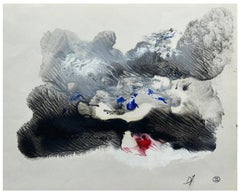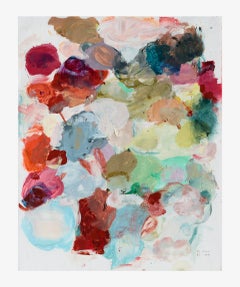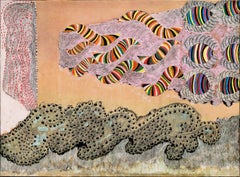GALERIE CHARVET Abstract Drawings and Watercolors
to
1
Overall Width
to
Overall Height
to
1
1
1
1
1
1
1
1
1
Abstract composition
By Dora Maar
Located in PARIS, FR
Dora Maar
Abstract composition
Oil on paper
21 x 29.5 cm (31,2 x 39,3 cm with frame)
Signed lower right
Stamp of the sale of his estate (1998) lower right
Category
20th Century Abstract Abstract Drawings and Watercolors
Materials
Paper, Oil
Related Items
Field Study #749
By Terrell James
Located in Houston, TX
Terrell James
Field Study #749, 2020
Oil on vellum
20 x 16 in (50.8 x 40.6 cm)
Category
21st Century and Contemporary Abstract Abstract Drawings and Watercolors
Materials
Oil, Vellum
'Mid-century Abstract', NYMoMA, Paris, XXXII Venice Biennale, MALI, Lima, Peru
By Emilio Rodríguez Larraín
Located in Santa Cruz, CA
'Midcentury Biomorphic Abstract', NYMoMA, Paris, XXXII Venice Biennale, MALI, Lima, Peru
Signed, lower right, 'E.R. Larrain' for Emilio Rodríguez Larraín (Peruvian, 1928-2015), and inscribed 'Roma, Nov 1963, Enero 1964'. (Rome, Nov 1963-January 1964). Verso titled, "L'Homme C'est Sujet à Errer" (Man Tends to Wander), and bearing the artist's self-portrait in india ink and wash.
Exhibited: XXXII Venice Biennale, 1964. (original exhibition label verso)
Previously with Staempfli Galleries, New York. This painting is registered in the Archives of American Art as 'Staempfli Gallery, inventory #775'.
A monumental and historically distinguished work by this groundbreaking Peruvian Modernist who drew inspiration from Peruvian indigenous and pre-colonial culture. The paintings of Emilio Rodríguez Larraín are held in the permanent collections of museums worldwide including the Musée de la Ville de Paris, Peru's Museo de Arte de Lima and the Museum of Modern Art in New York. This painting was selected by the Peruvian Government for exhibition at the XXXII Venice Biennale in 1964 and is the largest single recorded work by the artist.
Emilio Rodríguez Larraín received his Bachelors of Architecture in 1949 from Peru's Universidad Nacional de Ingeniería and held his first solo exhibition in Lima after visiting Europe in 1950. In 1951, he returned to Europe in the company of the artists Alfredo Ruiz Rosas and Joaquín Roca Rey...
Category
1960s Abstract Abstract Drawings and Watercolors
Materials
Fiberboard, Laid Paper, Oil
"Colorful Geometric Abstraction, " Simon Samsonian, Armenian Artist
Located in New York, NY
Simon Samsonian (1912 - 2003)
Colorful Geometric Abstraction, 1981
Oil on paper
16 x 22 inches
Signed and dated lower right
Provenance:
Estate of the artist
This survivor of the Armenian genocide wound up in a Cairo orphanage in 1927. He rose to fame as one of Egypt’s great modernists, but after moving to Long Island late in life he withdrew into anonymity. Now his compelling story is being told. Art historians are finally beginning to realize that the power of abstraction in its early years was a zeitgeist not limited to the major European centers of the avant-garde — Paris, Munich, and Moscow — but one that quickly rippled to major cities throughout the world. Within a few decades that original shock of a new vision had inspired thousands of artists from different cultures — particularly those the Middle East — whose translations were not slavish imitations of works by seminal figures like Picasso, Braque, Malevich, and Kandinsky but creative variants colored by their respective cultures.
This essay focuses on an extraordinary Armenian artist, his harrowing survival of the genocide, his rise to fame in Cairo, and his creation of a unique style of abstraction. Art historians have typically formed a chorus that teaches the history of abstraction like this: Just before and during the World War I era, several avant-garde artists emerged to create shockingly different new forms by which artists could express themselves. In Paris, Picasso and Braque broke out with cubism, quickly followed by Mondrian. In Moscow, Malevich created Suprematism, the ultimate hard-edge geometric abstraction. And in Munich, Kandinsky emerged as the father of Abstract Expressionism. Within these few short years a zeitgeist was sensed throughout the art world. American pioneers, too — particularly Stanton Macdonald-Wright and Morgan Russell — felt this explosive freedom of expression. When Europe was recovering after World War I it became clear that Paris would retain its title as capitol of the art world, lasting through the Roaring Twenties and even through the Great Depression. But the end of World War II changed everything. A parallel war had been won by a group of irascible young Abstract Expressionists in New York — led by Pollock, Rothko, DeKooning, and Kline. No sooner had Paris been liberated from the Germans than Picasso, Matisse, Breton, and Duchamp surrendered to the Americans. From that point on New York would be the epicenter of the art world.
But a lens that focuses myopically on the war between the avant-garde of Paris and New York misses the wider narrative of multiple aesthetic modernities that developed in the several decades following World War I. For Armenian artists the matter is even more complex owing to the genocide of 1915 where more than 1.5 million people — seventy-five percent of Armenians in the Ottoman Empire — were massacred. Those not shot on the spot were sent on death marches through the Mesopotamian desert without food or water. Frequently, the marchers were stripped and forced to walk naked under the scorching sun until they dropped dead.
As a child Samsonian witnessed the murder of his parents and most of the members of his family. Soon thereafter, his older sister, Anahid, quickly shepherded him into a line of children being rescued by Greek nuns. But they became separated and he lost her, too. He was sent to a Greek orphanage in Smyrna (now Izmir), on Turkey’s west coast. Because he only knew his first name, the orphanage gave him a last name based on the place where they found him — Samsun — a major port on Turkey’s north coast on the Black Sea. His birth date was unknown, too. According to Samsonian’s vague recollections he assumed he was about three or four years old at the onset of the genocide, which would place his birth year in 1911 or 1912. In 1922, when Samsonian was about 10, the Turks ended their war with the Greeks by putting Smyrna to the torch in what has been called the “Catastrophe of Smyrna.” Once again, the child was on the run, escaping the fire and slaughter. He found temporary refuge in Constantinople, but within a year that major port would fall to the Turks, too, and become renamed as Istanbul. This time, Samsonian was whisked away to an orphanage in Greece founded by the American charity, Near East Relief — which is credited with saving so many Armenian orphans that the American historian Howard M. Sachar said it “quite literally kept an entire nation alive.
Any understanding of Samsonian’s approach to modernism requires careful consideration of the impact of his early years because his art is inseparable from the anguish he experienced. In 1927, when he was a teenager, he was transferred to Cairo, Egypt, then a cosmopolitan city hosting a sizable portion of the Armenian diaspora. There he lived with thirty-two other children on the top floor of the Kalousdian Armenian School. Upon graduating in 1932 he won a scholarship to attend the Leonardo da Vinci Art Institute — an Italian art school in Cairo — where he won first prize in final examinations among one hundred students. He found work with an Armenian lithographic printer and he returned to the Kalousdian Armenian School to teach drawing. In 1939 he married one of his students, Lucy Guendimian.
The Cairo in which Samsonian matured as an artist was home to many prominent art collectors after World War I. In this receptive environment Samsonian exhibited widely and won many awards. Beginning in 1937 and for the next thirty years he exhibited annually at the prestigious Le Salon du Caire hosted by the Société les Amis de l’Art (founded in 1921). After World War II he hit his stride as a modernist in Cairo, counting among his peers other artists of the Armenian diaspora such as Onnig Avedissian, Achod Zorian, Gregoire Meguerdichian, Hagop Hagopian...
Category
1980s Abstract Geometric Abstract Drawings and Watercolors
Materials
Paper, Oil
City with Cars
By Kathryn Lynch
Located in Fairfield, CT
Excerpt from Mark Segal, "An Artist at the Mercy of Her Subjects," The East Hampton Star, May 14, 2015
"Ms. Lynch paints recognizable things, and she alw...
Category
21st Century and Contemporary Abstract Abstract Drawings and Watercolors
Materials
Handmade Paper, Oil
"Untitled" Hans Hofmann, circa 1943 Navy Blue Olive Green Early Abstract Work
By Hans Hofmann
Located in New York, NY
Hans Hofmann
Untitled, circa 1943
Signed lower right
Oil and watercolor on paper
22 1/4 x 30 3/4 inches
The only artist of the New York school to participate directly in European m...
Category
1940s Abstract Expressionist Abstract Drawings and Watercolors
Materials
Paper, Oil, Watercolor
Follow the pink rabbit - line drawing woman figure
By Mila Akopova
Located in Fort Lee, NJ
Interior design paintings. The artwork were done with oil, acrylic, ink and watercolor. The work are 11 by 14 inches in size, framed (black) with a styrene face on a mat board in whi...
Category
2010s Abstract Abstract Drawings and Watercolors
Materials
Paper, Acrylic, Watercolor, Oil
Abstract composition JCI, 1960-65 - mixed media, 85x124 cm, framed
By James Coignard
Located in Nice, FR
Mixed media, gouache and paper, signed .
James Coignard est un peintre, graveur et sculpteur français, né le 15 septembre 1925 à Tours et mort le 7 mars 2008 à M...
Category
Mid-20th Century Abstract Abstract Drawings and Watercolors
Materials
Paper, Oil
H 33.47 in W 48.82 in D 1.58 in
Abstract Expressionist Rue de Paris Oil on paper - Transfer Monotype
Located in Soquel, CA
Abstract Expressionist Rue de Paris
Original transfer Monotype painting by California artist Heather Speck (American 20th C) abstract scene using oil and...
Category
1990s Abstract Expressionist Abstract Drawings and Watercolors
Materials
Paper, Oil, Monotype
H 11.25 in W 15 in D 0.07 in
Untitled 04 - Contemporary, Abstract, Black, Organic, Small, Drawing
By Zsolt Berszán
Located in Baden-Baden, DE
Untitled 04, 2015 - 2016
Mixed technique: oil paint, adhesive on paper
(Signed on reverse, Framed)
8.26 H x 5.9 W in
21 H x 15 W cm
Zsolt Berszán’s work...
Category
2010s Abstract Abstract Drawings and Watercolors
Materials
Paper, Adhesive, Oil
H 11.03 in W 8.67 in D 2.76 in
Untitled 08 - Contemporary, Abstract, Black, Organic, Small, Drawing
By Zsolt Berszán
Located in Baden-Baden, DE
Untitled 08, 2015 - 2016
Mixed technique: oil paint, adhesive on paper
(Signed on reverse, Framed)
8.26 H x 5.9 W in
21 H x 15 W cm
Zsolt Berszán’s work speaks of repulsion and fasc...
Category
2010s Abstract Abstract Drawings and Watercolors
Materials
Paper, Adhesive, Oil
H 11.42 in W 9.06 in D 3.94 in
Good Friday, abstract female figure
By Tom Bennett
Located in Brooklyn, NY
Oil on paper, signature Tom Bennett freedom of rich brushwork, warm colors
Category
2010s Abstract Expressionist Figurative Drawings and Watercolors
Materials
Paper, Oil
Into the Sunset
By Andrei Petrov
Located in New York, NY
Andrei Petrov is an American artist of Russian origins. He is best known for his abstract oil paintings where calibrated stratifications of intense shades of colors are scraped to ex...
Category
2010s Abstract Expressionist Abstract Drawings and Watercolors
Materials
Paper, Oil


